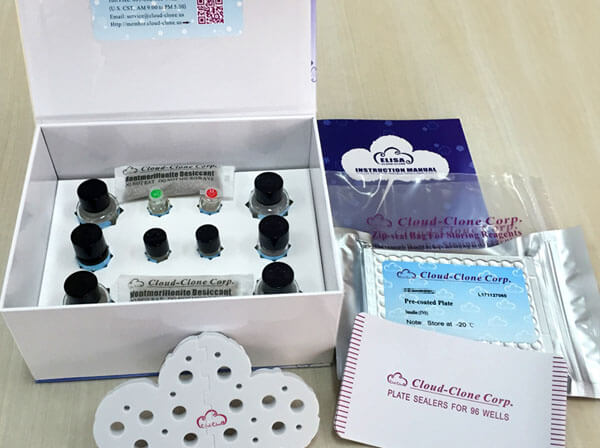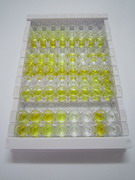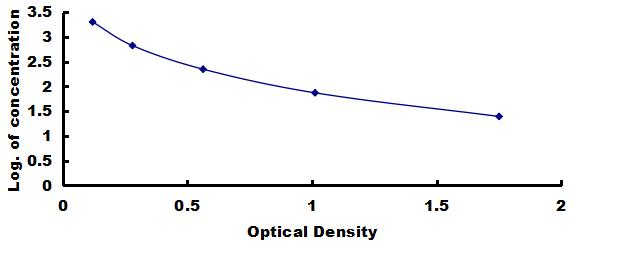ELISA Kit for Kisspeptin 1 (KISS1) 

Metastin; KiSS-1 Metastasis-Suppressor
- UOM
- FOB US$ 532.00 US$ 760.00 US$ 3,420.00 US$ 6,460.00 US$ 53,200.00
- Quantity
Overview
Properties
- Product No.CEC559Ra
- Organism SpeciesRattus norvegicus (Rat) Same name, Different species.
- ApplicationsEnzyme-linked immunosorbent assay for Antigen Detection.
Research use only - DownloadInstruction Manual
- CategoryTumor immunity
Sign into your account
Share a new citation as an author
Upload your experimental result
Review

Contact us
Please fill in the blank.
Recovery
Matrices listed below were spiked with certain level of recombinant Kisspeptin 1 (KISS1) and the recovery rates were calculated by comparing the measured value to the expected amount of Kisspeptin 1 (KISS1) in samples.
| Matrix | Recovery range (%) | Average(%) |
| serum(n=5) | 88-96 | 91 |
| EDTA plasma(n=5) | 96-105 | 101 |
| heparin plasma(n=5) | 93-102 | 98 |
Precision
Intra-assay Precision (Precision within an assay): 3 samples with low, middle and high level Kisspeptin 1 (KISS1) were tested 20 times on one plate, respectively.
Inter-assay Precision (Precision between assays): 3 samples with low, middle and high level Kisspeptin 1 (KISS1) were tested on 3 different plates, 8 replicates in each plate.
CV(%) = SD/meanX100
Intra-Assay: CV<10%
Inter-Assay: CV<12%
Linearity
The linearity of the kit was assayed by testing samples spiked with appropriate concentration of Kisspeptin 1 (KISS1) and their serial dilutions. The results were demonstrated by the percentage of calculated concentration to the expected.
| Sample | 1:2 | 1:4 | 1:8 | 1:16 |
| serum(n=5) | 80-90% | 92-101% | 84-98% | 79-89% |
| EDTA plasma(n=5) | 92-101% | 82-104% | 81-102% | 78-104% |
| heparin plasma(n=5) | 79-99% | 91-102% | 93-101% | 91-101% |
Stability
The stability of kit is determined by the loss rate of activity. The loss rate of this kit is less than 5% within the expiration date under appropriate storage condition.
To minimize extra influence on the performance, operation procedures and lab conditions, especially room temperature, air humidity, incubator temperature should be strictly controlled. It is also strongly suggested that the whole assay is performed by the same operator from the beginning to the end.
Reagents and materials provided
| Reagents | Quantity | Reagents | Quantity |
| Pre-coated, ready to use 96-well strip plate | 1 | Plate sealer for 96 wells | 4 |
| Standard | 2 | Standard Diluent | 1×20mL |
| Detection Reagent A | 1×120µL | Assay Diluent A | 1×12mL |
| Detection Reagent B | 1×120µL | Assay Diluent B | 1×12mL |
| TMB Substrate | 1×9mL | Stop Solution | 1×6mL |
| Wash Buffer (30 × concentrate) | 1×20mL | Instruction manual | 1 |
Assay procedure summary
1. Prepare all reagents, samples and standards;
2. Add 50µL standard or sample to each well.
And then add 50µL prepared Detection Reagent A immediately.
Shake and mix. Incubate 1 hour at 37°C;
3. Aspirate and wash 3 times;
4. Add 100µL prepared Detection Reagent B. Incubate 30 minutes at 37°C;
5. Aspirate and wash 5 times;
6. Add 90µL Substrate Solution. Incubate 10-20 minutes at 37°C;
7. Add 50µL Stop Solution. Read at 450 nm immediately.

Test principle
This assay employs the competitive inhibition enzyme immunoassay technique. An antibody specific to KISS1 has been pre-coated onto a microplate. A competitive inhibition reaction is launched between biotin labeled KISS1 and unlabeled KISS1 (Standards or samples) with the pre-coated antibody specific to KISS1. After incubation the unbound conjugate is washed off. Next, avidin conjugated to Horseradish Peroxidase (HRP) is added to each microplate well and incubated. The amount of bound HRP conjugate is reverse proportional to the concentration of KISS1 in the sample. After addition of the substrate solution, the intensity of color developed is reverse proportional to the concentration of KISS1 in the sample.
Giveaways
Increment services
Citations
- LIM-homeodomain transcription factor Isl-1 mediates kisspeptin's effect on insulin secretion in mice.Pubmed:24956377
- 双酚A 与女童性早熟的关系Fileup: Pdf
- The relation of urinary bisphenol A with kisspeptin in girls diagnosed with central precocious puberty and premature thelarchePubMed: 26565542
- Circulating levels of leptin, nesfatin-1 and kisspeptin in postmenopausal obese womenPubmed:27011110
- The Changes of Serum Leptin and Kisspeptin Levels in Chinese Children and Adolescents in Different Pubertal Stagespubmed:27990162
- Basal Serum Neurokinin B Levels in Differentiating Idiopathic Central Precocious Puberty from Premature Thelarche.pubmed:28008860
- Kisspeptin Protein in Seminal Plasma Is Positively Associated with Semen Quality: Results from the MARHCS Study in Chongqing, China
- Lack of Improvement of Sperm Characteristics in Obese Males After Obesity Surgery Despite the Beneficial Changes Observed in Reproductive HormonesPubmed: 30806913
- Serum Kisspeptin and Its Relation to Metabolic Parameters and Glucose Metabolism in Prepubertal and Pubertal Obese ChildrenPubmed: 33224197
- KISS1R Signaling Modulates Gonadotropin Sensitivity in Mouse Leydig CellPubmed: 33112765
- Beyond GnRH, LH and FSH: the role of kisspeptin on hypothalalmic-3 pituitary gonadal (HPG) axis pathology and diagnostic consideration 4
- Kisspeptin and Hematologic Parameters as Predictive Biomarkers for First-Trimester Abortions34239761
- Comparison of the Kisspeptin levels in early onset preeclampsia and late-onset preeclampsiaPubmed:35039882
- Serum kisspeptin, leptin, neuropeptide Y, and neurokinin B levels in adolescents with polycystic ovary syndromePubmed:35170267
- Differential Expression of Kisspeptin System and Kisspeptin Receptor Trafficking during Spermatozoa Transit in the EpididymisPubmed:35205340

















